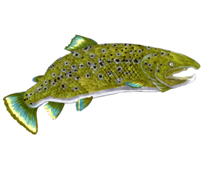Fish Files in your Backyard
Atlantic Salmon (Salmon salar)

Where do I live?
As my name suggests, I live in the Atlantic Ocean in artic zones in the Northern Hemisphere. In the western Atlantic Ocean, I can be found in coastal drainages from northern Quebec in Canada, and from Conneticut to Argentina in the United States. In the eastern Atlantic Ocean you can find me from Northern Europe to Portugal. There are also some populations of me found in landlocked countries such as Russia, Finland, Sweeden, Norway and North America.
What do I look like?
I am a unique fish that has several body colourations and body patterns depending on my stage of life. When we are young fish living in freshwater we have 8-11 par marks (black patches) with one red spot between each mark. Adults living in saltwater will be blue-green in colour, with a silvery coating and a few spots on the upper part of their body. When it is time for reproduction and migrating to freshwater breeding grounds, adults will become greenish or reddish brown, flecked with red or orange and a few black spots.
What do I eat?
As a juvenile fish living in freshwater, I tend to eat insects such as blackflies, stoneflies and caddisflies. My diet can also include mollusks, crustaceans and fish. As adults living in the Atlantic Ocean, our diet consists of squid, shrimp and fish. For large adults the fish we eat are herring, alewives, smelt, capelin, small mackerel and small cod.
What is unique about me?
I am what you call Anadromous (a-nad-ro-mous). This means that I swim in both salt and freshwater. I am born in freshwater rocky streams and will spend 1-6 years in this habitat growing, before I make the long trip out to sea. Once I am an adult, I will live in the open ocean for 1-4 years before traveling upstream back to freshwater to spawn. The interesting thing about this journey is that I will return to the same spot that I was born.
There have been attempts to move us to new locations with little success. This is unfortunate because we used to be found in local areas such as Lake Ontario. Due to habitat loss from dam construction, logging, soil erosion, and over fishing from both recreational and commercial fishing, our numbers are smaller than they once were.
How Common am I?
Due to a history of heavy commercial fishing, my numbers have declined. In the United States and Canada, laws are in place to protect spawning rivers and anglers are limited in the number of fish they are allowed to catch. This has allowed us to slowly increase our numbers and repopulate spawning areas. I am now an aquaculture species for use in restocking programs and the commercial industry.
European Sturgeon (Acipenser sturio )

Where do I live?
I am a species of fish found in the Eastern Atlantic Ocean, along the European coast. A major part of my life is spent at sea. When migrating inland for spawning, I am only found in the Gironde River basin in France and the Rioni River basin in Georgia. I am a demersal (de-mer-sal) species of fish. This means that I am found near or in the deepest part of water. I prefer a soft, sandy or muddy substrate, and for spawning I like a shallow pool with a gravel bottom.
What do I look like?
On average I am 1-2 meters long, but can reach lengths of 3.5 meters and can weigh up to 150kg (330 lbs). I have an elongated body that is not covered in scales like most fish, but covered with pentagonal shaped sections. My head is wedge shaped and ends in a long point. I have four barbells on the lower portion of my face that I use to search for food. My dorsal fin is found really far back on my body. The colour of my body is a brownish-grey with a white belly.
What do I eat?
I am a bottom dwelling fish and feed on crustaceans, mollusks, marine bristle worms and small fish.
What is unique about me?
I am a solitary species of fish and spend a large portion of my life in deep water along the European coast. I reach sexual maturity at the age of 7-9 years old. When it comes time for breeding, I will travel upstream into freshwater to specific spawning grounds. Though I am usually fond in deep water, I am usually found in water no deeper that a couple meters when I spawn. Female European Sturgeon can produce 800,000-2,400,000 eggs.
How Common am I?
I am a species of fish that is not very common. I am considered critically endangered due to my highly prized flesh and eggs, which are used in the expensive caviar trade. Human dam construction has ruined much of my breeding habitat and prevents me from migrating upstream to spawn. I am protected under the Convention on International Trade in Endangered Species (CITES). This means that I am not allowed to be sold internationally. I am now involved in captive breeding programs designed to reintroduce me to areas once populated by European Sturgeon.
